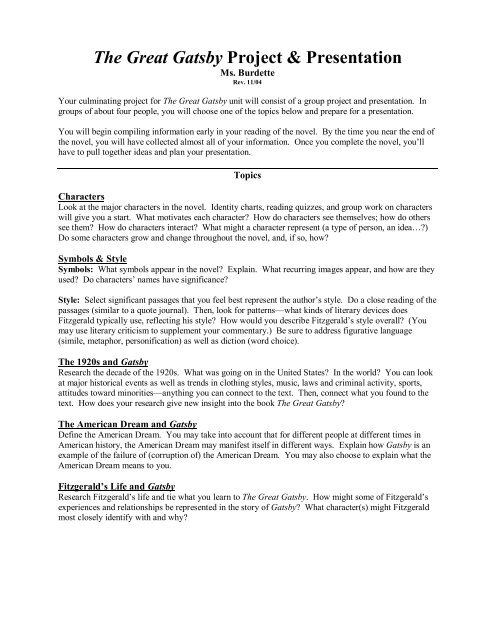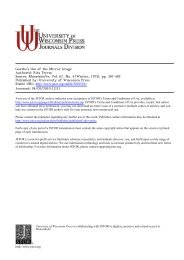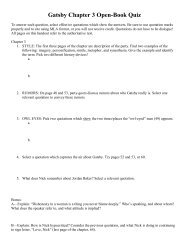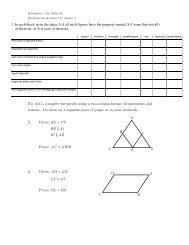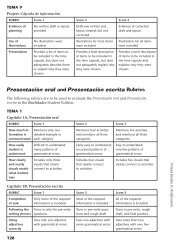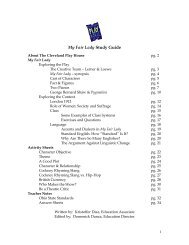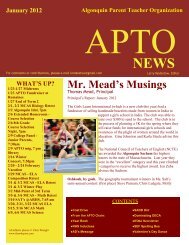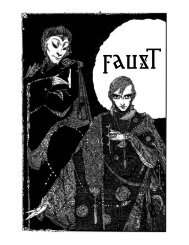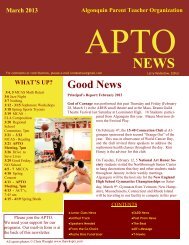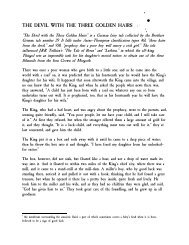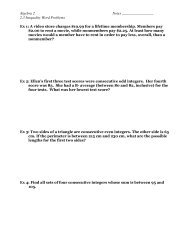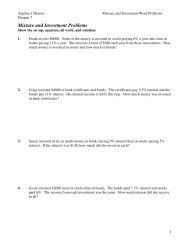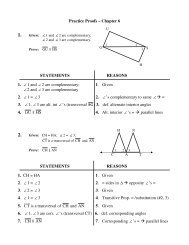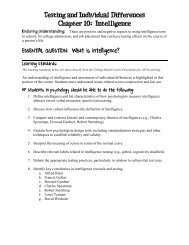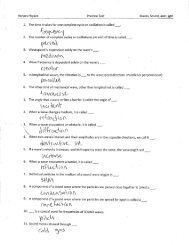The Great Gatsby Project & Presentation
The Great Gatsby Project & Presentation
The Great Gatsby Project & Presentation
You also want an ePaper? Increase the reach of your titles
YUMPU automatically turns print PDFs into web optimized ePapers that Google loves.
<strong>The</strong> <strong>Great</strong> <strong>Gatsby</strong> <strong>Project</strong> & <strong>Presentation</strong>Ms. BurdetteRev. 11/04Your culminating project for <strong>The</strong> <strong>Great</strong> <strong>Gatsby</strong> unit will consist of a group project and presentation. Ingroups of about four people, you will choose one of the topics below and prepare for a presentation.You will begin compiling information early in your reading of the novel. By the time you near the end ofthe novel, you will have collected almost all of your information. Once you complete the novel, you’llhave to pull together ideas and plan your presentation.TopicsCharactersLook at the major characters in the novel. Identity charts, reading quizzes, and group work on characterswill give you a start. What motivates each character? How do characters see themselves; how do otherssee them? How do characters interact? What might a character represent (a type of person, an idea…?)Do some characters grow and change throughout the novel, and, if so, how?Symbols & StyleSymbols: What symbols appear in the novel? Explain. What recurring images appear, and how are theyused? Do characters’ names have significance?Style: Select significant passages that you feel best represent the author’s style. Do a close reading of thepassages (similar to a quote journal). <strong>The</strong>n, look for patterns—what kinds of literary devices doesFitzgerald typically use, reflecting his style? How would you describe Fitzgerald’s style overall? (Youmay use literary criticism to supplement your commentary.) Be sure to address figurative language(simile, metaphor, personification) as well as diction (word choice).<strong>The</strong> 1920s and <strong>Gatsby</strong>Research the decade of the 1920s. What was going on in the United States? In the world? You can lookat major historical events as well as trends in clothing styles, music, laws and criminal activity, sports,attitudes toward minorities—anything you can connect to the text. <strong>The</strong>n, connect what you found to thetext. How does your research give new insight into the book <strong>The</strong> <strong>Great</strong> <strong>Gatsby</strong>?<strong>The</strong> American Dream and <strong>Gatsby</strong>Define the American Dream. You may take into account that for different people at different times inAmerican history, the American Dream may manifest itself in different ways. Explain how <strong>Gatsby</strong> is anexample of the failure of (corruption of) the American Dream. You may also choose to explain what theAmerican Dream means to you.Fitzgerald’s Life and <strong>Gatsby</strong>Research Fitzgerald’s life and tie what you learn to <strong>The</strong> <strong>Great</strong> <strong>Gatsby</strong>. How might some of Fitzgerald’sexperiences and relationships be represented in the story of <strong>Gatsby</strong>? What character(s) might Fitzgeraldmost closely identify with and why?
Content (50%)· Accuracy· Insight· Evidence<strong>Presentation</strong> (50%)· Visual (group)<strong>Gatsby</strong> <strong>Project</strong> & <strong>Presentation</strong> Grading· Evidence of planningo Index cards or noteso Transitions among group memberso Smooth delivery of presentation· Contribution by all group memberso Contribution to both preparation (in and out of class) and presentation· Speaking skillso Poise: seeming confident, making eye contact, avoiding distracting gestures &distracting or inarticulate words (like, um, sort of, you know, kind of, basically)o Vocal messages: projecting your voice, choosing appropriate pace, appropriate pausesRequirements:1. <strong>Presentation</strong>2. Works Cited—use MLA format. Refer to Writer’s Inc orhttp://www.dianahacker.com/resdoc/ go to “Humanities” (MLA). Don’t forgetto cite sources for graphics, as well as ideas and direct quotations.3. Visual:o No boring posters! If you use posters, make them creative, relevant, colorful, visuallyappealing, easy to see from a distance. Carefully consider your choices of color torepresent a particular character or theme. You may use multiple posters for a given topic.Posters do not have to be rectangular.o Overheads: if you print out a page from home, we can put the page on an overhead (blackand white only available at school). Be sure to use 16point font or larger. Use bullets,outline form, numbers, and “white space” to make text accessible. Consider graphics.o Handouts: you may consider creating handouts, especially if you have timelines orgraphic organizers which don’t translate easily to an overhead, poster, or PowerPoint—you might not be able to fit the information on an overhead, poster, or single slide andstill have it be visible. Handouts don’t have to be just text—consider graphics, and breakup text so it’s easy to see.o PowerPoint: Again, consider font size. Don’t cram too much information on a slide—it’sbetter to include graphics and use several slides. Make the slides visually appealing andclear. We can project PowerPoint for the whole class to see. Don’t let bells and whistlesoverwhelm content—don’t worry about transitions between slides or font color until allcontent is established in all your slides. Keep color scheme consistent.o Anything else you feel is relevant—run other ideas by me. If you’re doing music in theJazz Age, you MUST play samples. If you’re doing pop culture and fashion, you coulddress up as a flapper. You could demonstrate swing dancing. You could create a piece ofart, 2 or 3dimensional, representing a symbol or character. You could create a wordportrait, “I am” poem, collage to represent a character. Be creative. Draw in youraudience.


